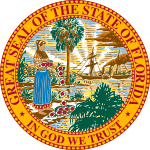History of Tampa, Florida
| History of Florida | |
|---|---|

The seal of Florida reflects the state's Native American ancestry
|
|
| Historical Periods | |
| Pre-history | until 1497 |
| Spanish Rule | 1513–1763 |
| British Rule | 1763–1783 |
| Spanish Rule | 1783–1821 |
| U.S. Territorial Period | 1822–1845 |
| Statehood | 1845–present |
| Major Events | |
| American Revolutionary War | 1775–1783 |
| War of 1812 | 1811–1814 |
| First Seminole War | 1817–1818 |
| Capitol moved to Tallahassee |
1824 |
| Second Seminole War | 1835–1842 |
| Constitutional convention | 1838 |
| Third Seminole War | 1855–1858 |
| Ordinance of Secession | 1861 |
| Civil War | 1861–1865 |
| 3rd Constitution | 1865 |
| Reconstruction | 1865–1868 |
| 4th Constitution | 1868 |
| 5th Constitution | 1885 |
| Great Migration | 1910–1930 |
| Land Boom | 1925–1929 |
| 6th Constitution | 1968 |
|
Gore v. Harris 2000 Presidential Election |
2000 |
| Timeline | |
Tampa /ˈtæmpə/, a United States city in Hillsborough County on the west coast of the state of Florida.
Human habitation in the Tampa Bay area can be traced back thousands of years. The Manasota culture is the earliest documented group, spanning from about 500 BCE until about 700 CE, by which time it had evolved into the Safety Harbor culture. The and the Pohoy were of this culture, and these were the dominant tribes living along the northern shore of Tampa Bay when Spanish explorers arrived in the early 1500s. Though Spain claimed all of Florida as its possession, it could not successfully establish a settlement on the west coast and did not attempt to do so after the mid-1500s. However, European contact with native peoples spread diseases which devastated local populations. By the mid-1600s, indigenous social structures had collapsed, and the Tampa Bay area was left largely uninhabited.
Tampa's modern history can be traced to the founding of Fort Brooke at the mouth of the Hillsborough River in today's downtown in 1824, soon after the United States had taken possession of Florida from Spain. The outpost brought a small population of civilians to the area, and the town of Tampa was first incorporated in 1855.
Growth came slowly and sporadically for the village of Tampa during its first half-century, as poor transportation links, conflicts with the Seminole tribe, and repeated outbreaks of yellow fever made development difficult. The United States Civil War and Reconstruction were especially tough times, so much so that the city government disincorporated for over a decade.
...
Wikipedia
